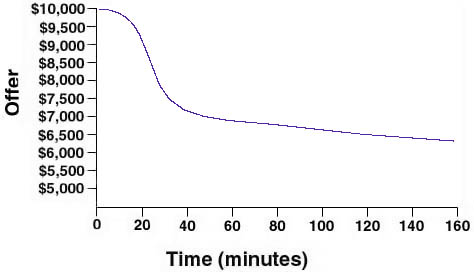
◙◙◙◙◙◙◙◙◙◙◙◙◙◙◙◙◙◙◙◙◙◙◙◙◙◙◙◙◙◙◙◙◙◙◙◙◙◙◙◙◙◙◙◙◙◙◙◙◙◙◙◙◙◙◙◙◙◙◙◙◙◙◙◙◙◙◙◙◙◙◙◙◙◙◙◙◙◙◙◙◙◙◙◙◙◙◙◙◙◙◙◙◙◙◙◙◙◙◙◙◙◙◙◙◙◙◙◙◙◙◙◙◙◙◙◙◙◙◙◙◙◙◙
Broad Types of Concession Curves:
People's concession curves might be characterized as falling into one of a few broad
categories.
Instead of the straight line described earlier, some people's concession making follows curves.
One type of concession curve looks sort of like a the letter "L". Suppose your
opponent makes
large concessions early on, and then stops making large concessions. His concessions get smaller in order to
convey a "firmness" in his bargaining position.

If you know this is how your opponent behaves, then when he shifts from making large concessions to making
small ones, then you know that you have received about as good an offer as you are likely to get from him.
Such individuals often get very irritated if you make very small concessions when they are making large ones --
they feel that you are trying to take advantage of them or you are not serious about negotiating.
| Review Question: | ||
|---|---|---|
| The dealer made large concessions
for the first hour, but then, after an hour of bargaining, shifted
strategy and made small concessions as shown in the graph above. Based on the information presented in the tutorial, the car dealer: |
||
| Is unlikely to sell the car for less than $6,000 | ||
|
|
Is willing to sell the car for $5,500 but is simply "pausing" in his concession making. | |
|
|
Is waiting to see what you do before resuming large concession making. | |
|
|
Is unlikely to sell the car for less than $9,000. | |
◙◙◙◙◙◙◙◙◙◙◙◙◙◙◙◙◙◙◙◙◙◙◙◙◙◙◙◙◙◙◙◙◙◙◙◙◙◙◙◙◙◙◙◙◙◙◙◙◙◙◙◙◙◙◙◙◙◙◙◙◙◙◙◙◙◙◙◙◙◙◙◙◙◙◙◙◙◙◙◙◙◙◙◙◙◙◙◙◙◙◙◙◙◙◙◙◙◙◙◙◙◙◙◙◙◙◙◙◙◙◙◙◙◙◙◙◙◙◙◙◙◙◙